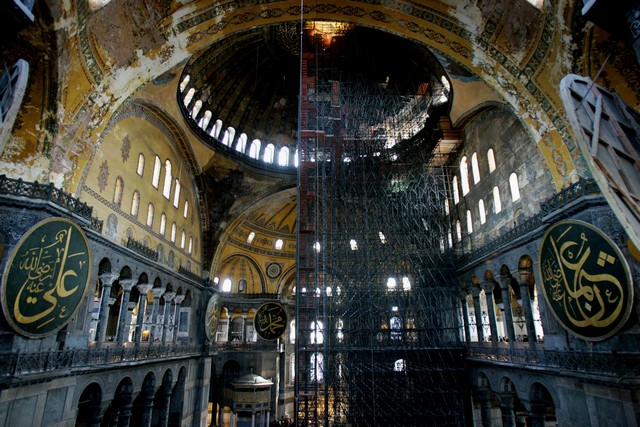By Abdullah al-Ahsan.
The News Desk of World Bulletin has reported last May 31 that “The Imam of the Ka’bah, Islam’s holiest site in Mecca, Abdullah Basfar, led thousands in a dawn prayer congregation outside of the Hagia Sofia on Saturday morning, before the congregation raised their hands in supplication asking for it to be reverted into a mosque.” This demand, in our opinion, is a blasphemous one. It is well-known to all Muslims that the second caliph ‘Umar ibn al-Khattab, declined an invitation by the church leaders to pray inside the Church when the Caliph was negotiating a peace agreement with the local Christian leaders at the Holy Sepulchre in Jerusalem. When the time for ‘asr prayer approached, he came out of the mosque and prayed outside of the church fearing that the latter Muslims might take that instance as an evidence for converting a church into a mosque. A new mosque was constructed at the site where the caliph prayed and that mosque is now known as Masjid ‘Umar bin al-Khattab or Umar Mosque. This and other instances of and practices of the immediate companions of the Prophet have been taken as a valid foundation for Islamic legal system later developed by the community. Any violation of the spirit of this system is considered sacrilegious.
However, the apparent question that arises in this context is that why Sultan Mehmet, the liberator of Constantinople, converted the Hagia Sophia or the Divine Wisdom (in Greek) into a mosque. This is a valid question which must be understood in the context of time. The liberation of Constantinople occurred at a time that witnessed centuries of anti-Muslim wars and violations by the crusading Europeans. Muslims and non-Catholics fought years of bloody wars against the crusaders. The 1453 liberation occurred at a time when the crusader Spanish Catholics were engaged in converting mosques into cathedrals in an effort to erase almost eight hundred years of Muslim rule in Andalusia. At that time it was necessary for Muslim leaders to demonstrate Muslim political, military and religious powers. Historically speaking, the Sultan’s act did significantly contribute to stabilize the Muslim presence in Europe. As for the position that the Sultan took during that specific situation, i.e. to convert the church into a mosque, one must acknowledge that this was an exception, not rule. Similar exceptions are allowed in Islamic jurisprudence and they are heavily entrenched in the Islamic tradition.
The time has changed again: Muslim places of worship are no more destroyed or converted into cathedrals in Europe. In fact, the positive approach developed by the Catholic and other denominations has allowed establishment of hundreds and thousands of mosques all over Europe during the past couple of centuries. The acceptance of the presence of Muslims has reached to the point that the Vatican, the seat of the Catholic Church has allowed calling of Muslim prayer – adhan – in its vicinity. With these developments, one may suggest that if Sultan Mehmet were alive today, he would have re-considered his own decision to convert Hagia Sophia to mosque under the changed circumstances. Mustafa Kemal Ataturk’s decree of 1934 might have been an immediate reaction to certain practices of some late Ottoman rulers, but to reverse that decree would be a disaster now. The younger generation led by the Anatolia Youth Association that is engaged in campaigning to revert the status of Ayasofia, as it is known in the Turkish language, into a mosque must understand universal Islamic teachings in the proper context of time. They should rather engage themselves in more constructive campaigns by participating and responding to Islamophobic expressions in this era of internet-based web media and the vibrant social media.
It is interesting to note that two Turkish opposition parties, the MHP and CHP, both claimed to be believers in secularism are reported to have demanded to turn Hagia Sophia into a mosque. According to a report, “Sinan Aygun, an MP of the Republican People’s Party for Ankara has posed the question as to why the Hagia Sofia shouldn’t be turned into a mosque in the Turkish parliament, following a call to turn the museum into a mosque by a member of Turkey’s third biggest party (National Movement Party) MHP. (World Bulletin Nov. 27, 2013)” This is nothing but exploitation of religious sentiment in politics. The Hagia Sophia does not represent any civilizational glory or power anymore; today the real civilizational power must be demonstrated through the ability to stand firm on one’s own footing. Turkey’s transformation during the past decade from aid recipient to aid donor country is the real manifestation of civilizational dignity, glory and prestige.
The Economist (May 10, 2014) reported from Istanbul that, “Turkey’s pious prime minister, Recep Tayyip Erdogan, plans to lead prayers in the building to mark the 561st anniversary (May 29, 2014).” But that has not happened: the date has passed without any such incident. However, what the Economist correspondent failed to note was that the Prime Minister had stated last year that, “he would not consider changing Hagia Sophia’s status as long as another great Istanbul house of worship, the 17th Century Sultan Ahmed Mosque, remains mostly empty of worshippers. Istanbul boasts more than 3,000 mosques.” Recently Deputy Prime Minister Bulent Arinc has described the conversion attempt as a trap. In our opinion, it is certainly a trap and sheer exploitation of emotional attachment of the Turkish masses to Sultan Mehmet – the Fatih, the liberator. The opposition and the Gulen supporters are trying to exploit this. The people of Turkey must understand this and act wisely.
Dr. Abdullah al-Ahsan is Vice-President of JUST.
18 July 2014.

